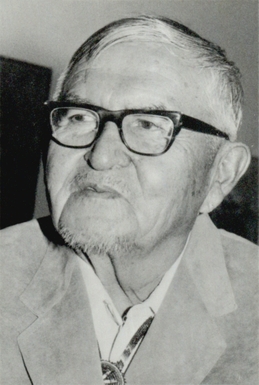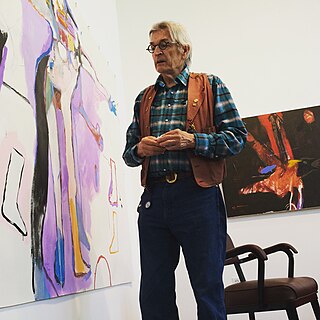Kevin Red Star is a Native American painter from Montana. He is a member of the Crow Tribe of Montana.

Allan Capron Houser or Haozous was a Chiricahua Apache sculptor, painter, and book illustrator born in Oklahoma. He was one of the most renowned Native American painters and Modernist sculptors of the 20th century.

Fritz William Scholder V was a Native American artist, who produced paintings, monotypes, lithographs, and sculptures. Scholder was an enrolled member of the La Jolla Band of Luiseno Indians, a federally recognized tribe of Luiseños, a California Mission tribe. Scholder's most influential works were post-modern in sensibility and somewhat Pop Art in execution as he sought to deconstruct the mythos of the American Indian. A teacher at the Institute of American Indian Arts (IAIA) in Santa Fe in the late 1960s, Scholder instructed prominent Native American students.

Harry Eugene Fonseca was a Nisenan Native American artist, and illustrator. He was an enrolled citizen of the Shingle Springs Band of Miwok Indians.
Mario Martinez is a Native American contemporary abstract painter. He is a member of the Pascua Yaqui Tribe from New Penjamo, the smallest of six Yaqui settlements, in Arizona. He lives in New York City.

Michael Kabotie, also known as Lomawywesa was a Hopi silversmith, painter, sculptor, and poet. He is known for his petroglyph and geometric imagery.

George Morrison was an Ojibwe abstract painter and sculptor from Minnesota. His Ojibwe name was Wah Wah Teh Go Nay Ga Bo. Morrison's work is associated with the Abstract Expressionist movement in the United States.
Kay WalkingStick is a Native American landscape artist and a member of the Cherokee Nation. Her later landscape paintings, executed in oil paint on wood panels often include patterns based on Southwest American Indian rugs, pottery, and other artworks.

Richard Elmer "Rick" Bartow was a Native American artist and a member of the Mad River band of the Wiyot Tribe, who are indigenous to Humboldt County, California. He primarily created pastel, graphite, and mixed media drawings, wood sculpture, acrylic paintings, drypoint etchings, monotypes, and a small number of ceramic works.

Linda Lomahaftewa is a Native American printmaker, painter, and educator living in Santa Fe, New Mexico. She is a citizen of the Hopi Tribe and a descendant of the Choctaw Nation of Oklahoma.

James Luna was a Puyukitchum, Ipai, and Mexican-American performance artist, photographer and multimedia installation artist. His work is best known for challenging the ways in which conventional museum exhibitions depict Native Americans. With recurring themes of multiculturalism, alcoholism, and colonialism, his work was often comedic and theatrical in nature. In 2017 he was awarded a Guggenheim Fellowship.
Robert James "Jim" Schoppert was an Tlingit Alaska Native artist and educator. His work includes woodcarving, painting, poetry, and essays. He has been described as an innovator, whose works pushed the boundaries of what was expected from Northwest Coast art.
Dyani White Hawk is a contemporary artist and curator of Sicangu Lakota, German, and Welsh ancestry based out of Minnesota. From 2010 to 2015, White Hawk was a curator for the Minneapolis gallery All My Relations. As an artist, White Hawk's work aesthetic is characterized by a combination of modern abstract painting and traditional Lakota art. White Hawk's pieces reflect both her Western, American upbringing and her indigenous ancestors mediums and modes for creating visual art.
Lawrence Paul Yuxweluptun is a Cowichan/Syilx First Nations contemporary artist from Canada. His paintings employ elements of Northwest Coast formline design and Surrealism to explore issues as environmentalism, land ownership, and Canada's treatment of First Nations peoples.
Cara Romero is an American photographer known for her digital photography that examines Indigenous life through a contemporary lens. She lives in both Santa Fe, New Mexico and the Mojave Desert. She is an enrolled citizen of the Chemehuevi Indian Tribe.
Duane Slick is a Meskwaki artist and educator of Ho-Chunk descent. He is known for his monochromatic paintings. He has taught fine arts at Rhode Island School of Design (RISD) since 1995.

Yatika Starr Fields is a Native American painter, muralist and street artist, born in the city of Tulsa, Oklahoma. His artworks were shown at numerous galleries and museums, including the APEC Young Artist Exhibition and recently in the Sam Noble Museum.
Melissa Melero-Moose is a Northern Paiute/Modoc mixed-media artist and co-founder of Great Basin Native Artists, a collective based in Nevada. She is enrolled in the Paiute-Shoshone Tribe of the Fallon Reservation and Colony.
Frank Raymond LaPena, also known as Frank LaPeña and by his Wintu name Tauhindauli, was a Nomtipom-Wintu American Indian painter, printmaker, ethnographer, professor, ceremonial dancer, poet, and writer. He taught at California State University, Sacramento, between 1975 and 2002. LaPena helped defined a generation of Native artists in a revival movement to share their experiences, traditions, culture, and ancestry.
Gorman Museum of Native American Art is a museum focused on Native American and Indigenous artists, founded in 1973 at University of California, Davis in Davis, California. It was formerly known as the Carl Nelson Gorman Museum, and the C.N. Gorman Museum.









